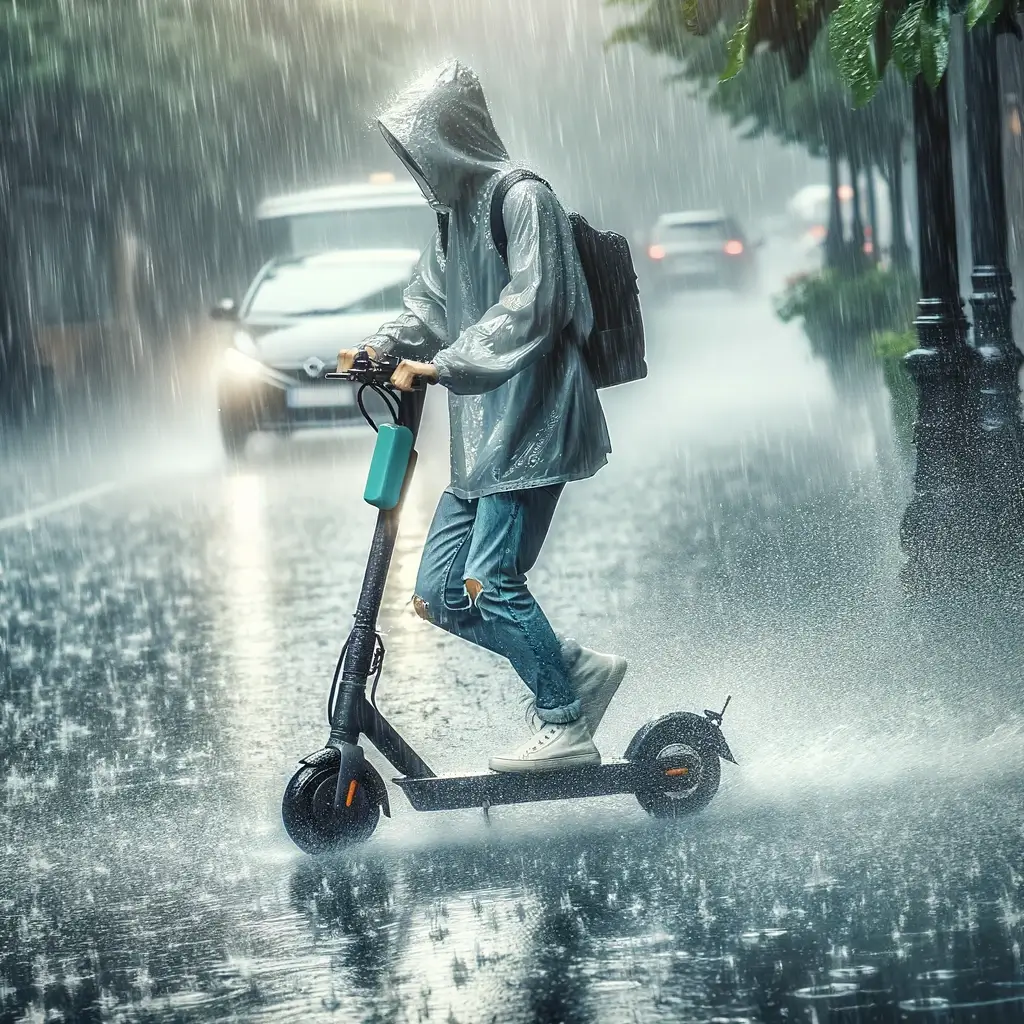How to Waterproof Your Electric Scooter: The Ultimate Guide
With the increasing popularity of electric scooters, ensuring their durability and functionality in various weather conditions, especially rain, is essential. Making electric scooters waterproof not only extends their lifespan but also enhances safety during wet conditions. If your scooter gets wet, then usually there is no risk involved when it’s not too long or a heavy rain shower, but prolonged exposure to wet conditions or riding in heavy rain can lead to a damaged electric scooter. This comprehensive guide will delve into practical steps you can take to waterproof your e-scooter effectively.
Understanding IP Ratings
The Ingress Protection (IP) rating of your scooter indicates its level of resistance to water and dust. Higher second digits in the IP rating (like IPX4, IPX5, etc.) denote better water resistance. Knowing this rating helps in determining the extent of waterproofing needed and keep your scooter on the road longer.
Understanding IP Ratings is crucial for assessing the water and debris resistance of electric scooters. The IP, or Ingress Protection, rating is a standard that indicates the level of protection an electric scooter offers against solid particles and liquids. The rating is usually presented as ‘IP’ followed by two digits. The first digit ranges from 0 to 6 and indicates the level of protection against solid objects like dust and debris. The second digit, ranging from 0 to 9, signifies the level of protection against liquids.
For example, an IP rating of IPX4 suggests that the scooter is protected against water splashes from all directions, which is suitable for riding in light rain or splashes. An IP54 rating offers similar water protection with the addition of significant dust protection. Higher ratings, like IPX5 or IP55, indicate that the scooter can handle low-pressure water jets from any direction, making it safe for riding in steady light rain and shallow puddles. An IPX6 or IP56 rating implies resistance to high-pressure water jets, suitable for more intense wet conditions.
The highest ratings, such as IPX7, indicate that the scooter can withstand temporary immersion in water up to 1 meter deep for 30 minutes, while IPX8 offers protection against prolonged immersion in water at greater depths.
It’s important to note that most electric scooters on the market today are at least water-resistant, with common ratings being IP54, offering some level of protection against light rain and dust. However, no electric scooter is entirely waterproof, and care should be taken when using them in wet conditions. Regular checks of the scooter’s components and appropriate storage are also recommended to maintain its condition.
Inspecting and Sealing Entry Points
Inspecting and sealing entry points is a crucial step to waterproof your scooter. Before starting the waterproofing process, it’s important to clean the scooter thoroughly with a soft cloth and mild soap. Once clean, inspect the wiring for any signs of damage or fraying. Select a suitable sealant that is compatible with your scooter’s materials, and carefully follow the instructions for application.
The electrical components of your scooter are especially vulnerable to water damage, so it’s important to seal them properly. First, inspect these components for any wear or damage while wearing protective gear. After inspection, apply a water-resistant coating or abrasion-resistant tape over the electrical connections to safeguard them from moisture and dirt. It’s crucial to ensure that the connections are completely sealed and dry before and after applying the sealant.
Another useful step is to use abrasion-resistant tape to provide a protective layer against the elements. This tape should be UV-resistant, temperature-resistant, and water-resistant. When applying the tape, make sure it covers the entire electrical component and is secured properly.
Finally, applying a waterproof membrane over the entire scooter, including cables and connections, will offer an additional layer of protection. This should be done with care, ensuring that all seals are checked for effectiveness. Regular maintenance and inspection of these seals will help prolong the scooter’s life and maintain its waterproofing.
Protecting the Battery
Protecting the battery of your electric scooter from rain and moisture is crucial for maintaining its longevity and functionality. Lithium-ion batteries, commonly used in electric scooters, can be sensitive to water and moisture, which can lead to various issues such as reduced efficiency, potential short circuits, or even fire hazards in extreme cases.
To safeguard the battery, always store your scooter in a dry, cool, and well-ventilated area, away from direct exposure to rain or humidity. This helps in minimizing the risk of moisture-related damage. When riding, try to avoid waterlogged areas and don’t submerge the scooter in water, as this can lead to water seeping into the battery compartment.
Proper charging practices are also important. Ensure that the scooter and its battery are completely dry before charging. Overcharging can lead to overheating, so use the recommended charger and follow the manufacturer’s guidelines. After riding in wet conditions, thoroughly dry your scooter, paying special attention to the battery area.
For added protection, consider using a waterproof cover for your scooter when it’s not in use, especially if you have to store it outdoors. Regularly inspect the battery for any signs of damage, swelling, or leakage, as these can be indicators of moisture ingress.
By following these precautions, you can significantly reduce the risks associated with moisture and rain exposure, ensuring a safer and more reliable performance from your electric scooter’s battery.
Choosing Wet Grip Tires
Choosing the right tires for your electric scooter is essential, especially when riding in wet conditions. When selecting tires for rainy weather, there are several factors to consider to ensure safety and optimal performance.
Firstly, it’s important to opt for tires that offer excellent grip on wet surfaces to minimize the risk of skidding or sliding. Pneumatic air-filled tires generally provide better performance than solid tires on wet surfaces. They deform better on impact, such as when rolling over potholes, offering great shock absorption and a more comfortable ride. This deformation also allows for better traction, which is crucial in wet conditions.
Additionally, tire pressure plays a significant role in the scooter’s handling in wet conditions. A lower tire pressure can result in better grip or traction, particularly when navigating slippery or wet terrains. The recommended tire pressure range for most electric scooters is typically within 40 to 50 PSI, but this can vary depending on the rider’s weight, the tire conditions, and the type of tires.
When choosing wet grip tires, it’s also important to consider the scooter’s overall waterproof rating. Look for scooters with a high IP (Ingress Protection) rating to ensure that the electrical components can withstand heavy rain showers without being compromised.
In summary, for riding in the rain, pneumatic tires with a lower pressure range are generally preferred for their better shock absorption and traction on wet surfaces. Always consider the scooter’s waterproof rating and adjust the tire pressure based on the specific riding conditions and the rider’s weight
Using Silicone Sealants
Using silicone sealants is an effective and common method to waterproof electric scooters, providing an extra layer of protection against moisture and water damage. Silicone sealants can be applied to various parts of the scooter to prevent water infiltration and make your E-scooter waterproof and water-resistant. Here’s how to use silicone sealants effectively:
- Sealing Non-Functional Holes: Many electric scooters have small, non-functional holes on their decks and around handlebars. It’s important first to assess whether these holes are non-functional. You can fill these holes with silicone to prevent water entry. The process involves cutting the nozzle of the silicone gun and filling these holes carefully.
- Protecting Connectors: The electrical connectors are particularly vulnerable to water damage. Applying a silicone-based coating to these connectors can provide additional protection. This involves uncovering the deck, spraying the silicone, and allowing it to dry completely, preferably for up to 12 hours. Ensure to clean any dirt between the connectors before applying silicone to prevent moisture and air from getting in.
- Application on Deck and Base Edges: Apply a layer of silicone sealant around the edges of the scooter’s deck and base. This can be extended to any exposed wires or electrical components. Ensure the silicone dries completely before using the scooter again.
- General Tips: When using silicone sealants, it’s important to ensure that you do not block any vents or sensors necessary for the scooter’s functionality. Also, after applying the silicone, allow sufficient time for it to dry to ensure effective waterproofing and prevent water damage.
Conclusion
- Understand and check your scooter’s IP rating for water resistance.
- Seal entry points and protect the battery from moisture.
- Regular maintenance is key to prolonging your scooter’s lifespan.
- Using waterproof covers and upgrading tires can enhance safety in wet conditions.
Remember, while these steps greatly improve water resistance, no scooter is entirely waterproof. Always exercise caution when riding in heavy rain or wet conditions.






